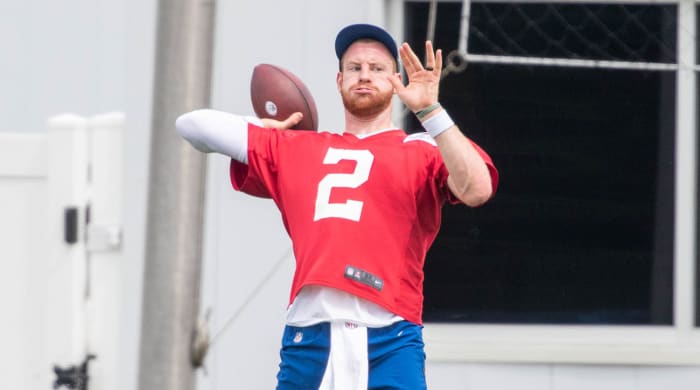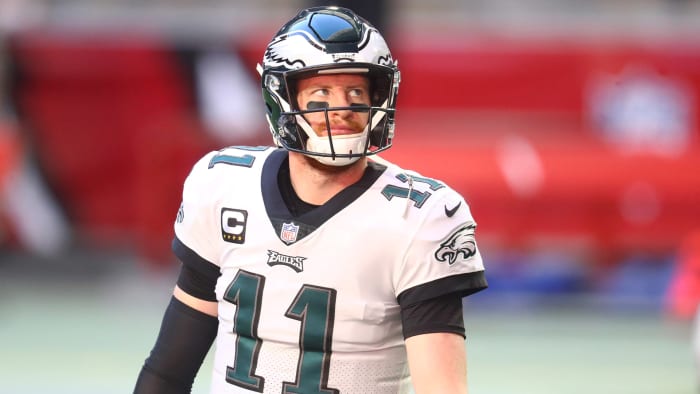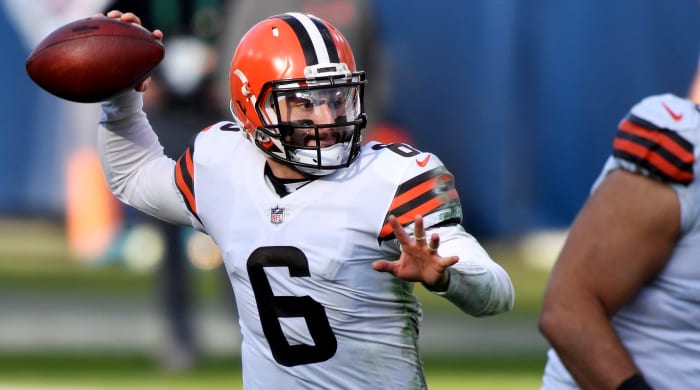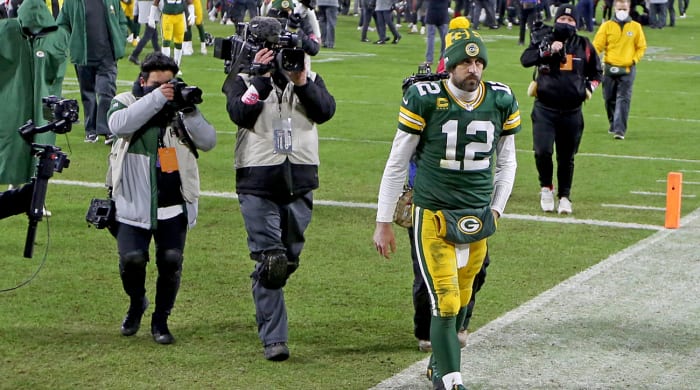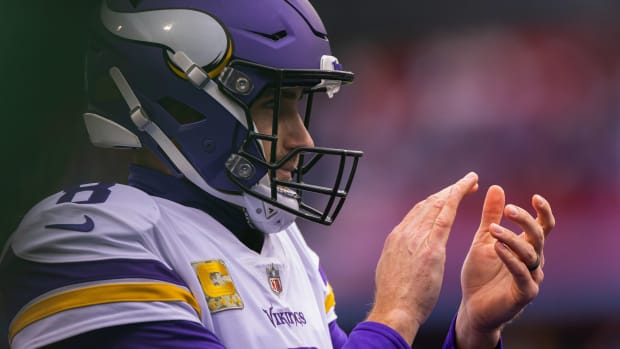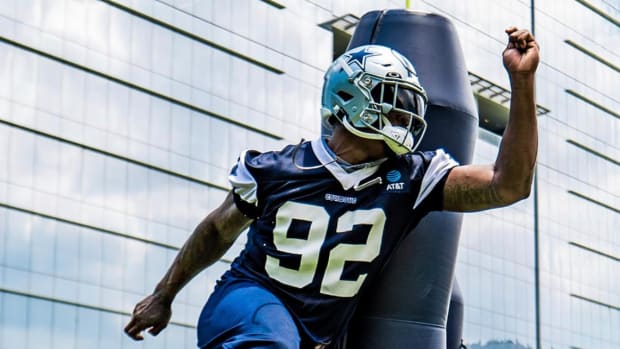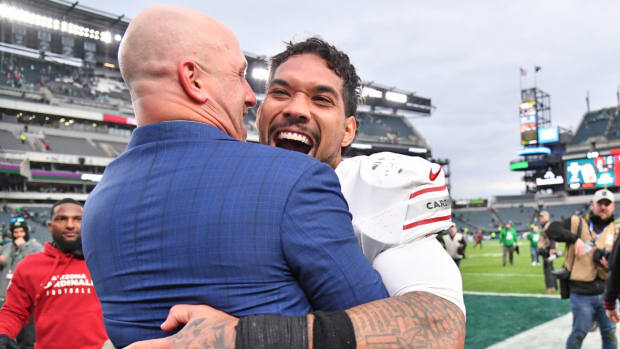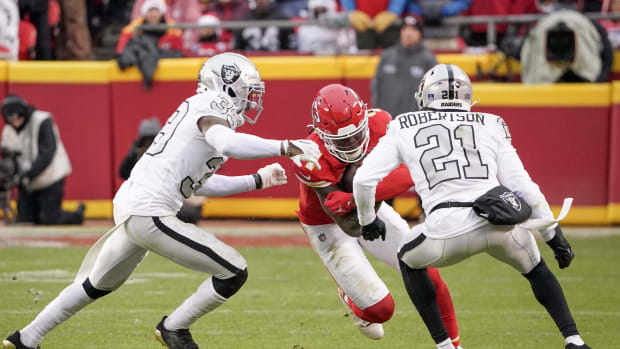MMQB: Carson Wentz Is Enjoying His Transition to Indianapolis on and off the Field
Carson Wentz is still in Indianapolis, two weeks after the Colts’ veterans broke for the summer—which was part of an agreement the team’s player leadership came to with the coaches to abbreviate the offseason program. No one suggested he stay. For Wentz, and where he is right now as a player, he saw it as the right thing, so he just did it.
That meant, during the week of Memorial Day, taking part in what coach Frank Reich had set up as a tacked-on, rookies-only week of OTAs, and a few of the receivers stuck around for that too. Last week, he threw some more in Indy with those guys, and this coming week, his throwing coach, Adam Dedeaux, is coming into town for some more individualized technical tune-up work.
And in July, Wentz will host a bunch of offensive skill players at his offseason home near Houston for a few days of throwing, Topgolf and just hanging out.
“We have good connections there for where we can go work out and have some fun,” Wentz said over the phone, on his way to a workout on Thursday. “It’s kind of a central place where it’s gonna be plenty hot, so guys can get acclimated for camp.”
No one needs to tell Wentz what he’s got on the line in 2021.
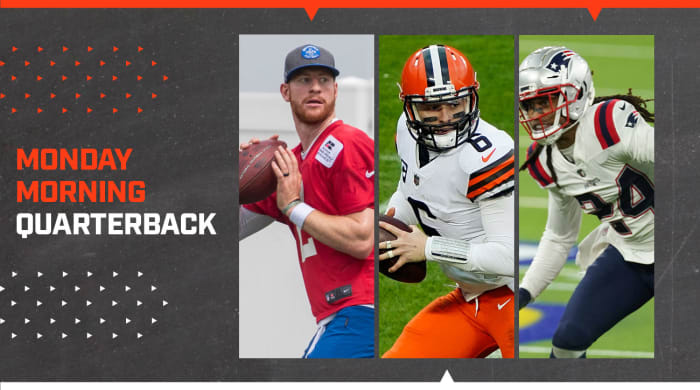
Trevor Ruszkowski/USA TODAY Sports (Wentz); Jay Biggerstaff/USA TODAY Sports (Mayfield); Kirby Lee/USA TODAY Sports (Gilmore)
In so many ways, he’s been granted a second NFL life after the Eagles traded him to a place that’s about perfect for him—from the coaching staff to the infrastructure of the roster around him to the region of the country he’s moving back to—and he’s not taking that new lease lightly. But in another way, what he has done and will be doing through the months of June and July is probably what he’d be doing anyway.
And if you need affirmation of that, Colts coach Frank Reich, Wentz’s coordinator in Philly during his first two years in the NFL, will give that to you. In that regard, the Wentz he’s seeing now is the Wentz he’s always known.
“I mean, anybody who’s been around Carson knows,” Reich said the other day. “There are many things that you cannot question, and certainly work ethic is one of them. Like a lot of our players, I’m not saying he works harder than them, but he works really, really hard. Very detailed in his work, very committed and very determined. … Some of it’s not uncommon. But it’s just the way he’s going about it, I think that is very good.”
In other words, Wentz is just being himself. He and the Colts know this time of year—with no losses incurred, sacks taken or interceptions thrown—it’s easy for him to be. The idea, of course, is for Wentz to be himself again, as he and Reich see him, when it’s not so easy.
For now? He’s doing everything he can to get there.
Offseason programs are winding down, but there’s still plenty for us to dig through in this week’s MMQB. Inside the column, you’ll find …
• A look at the Senior Bowl’s scout school.
• Big minicamp questions for this week.
• Nuggets on the Packers, Jets, Seahawks and Texans.
But we’re starting with the Colts’ big swing at quarterback, and how Wentz’s big shot at getting back to where he once was as a player is going.
That Wentz is very much being himself, at this early juncture, is one pretty encouraging sign for the Colts to take from the spring, if you remember what Reich told us back in March, a month after Indy agreed to send a 2021 third-round pick and a conditional ‘22 second-rounder (which will become a first-rounder if Wentz stays healthy and holds the job).
Then, and now, the whole idea was to let Wentz know he wasn’t arriving in Indy to be the next Andrew Luck, the next Peyton Manning or the next anything. They didn’t trade for a savior. They traded for a quarterback. And, as such, they only asked he be himself and play his position. That message has gotten through, loud and clear, to Wentz, which is one reason why, after just a few weeks with his new teammates, he’s comfortable just being himself.
“For sure,” Wentz said. “I think that’s something, even going to my time in Philly …”
Wentz then paused for a second, considering the weight of his time there, and maybe just how complicated it got, before gathering his thoughts.
“That’s something you try to do, you try to take that approach—I don’t need to do it all,” Wentz continued. “And I think human nature can sometimes get in the way of that. But I think Frank and really the rest of the offensive coaching staff, with what little work we’ve been able to do together, just really reinforced it. Throw to the open guy. First and second down, find a completion and move on. All that stuff. It’s been good.
“It’s been really healthy discussion, getting them to see how I see it, and me trying to see how they see the game, and building it together. I have a ton of respect for Frank not only as a man, but also as a coach, and just seeing what he’s done, with a different quarterback every year, and how he’s catered to their playing styles, what they do well, to put them in the best position to have success. And I saw him do that for me in Philly as well.”
Wentz then added, “I have the utmost confidence he’s gonna do that again.”
But all the same, Wentz has had to look in the mirror too, and the process of doing that led him to pack as much football as he could into his schedule, which he believes will give him the best shot at returning to the sort of form he lost in 2020.
That’s meant a few trips to Orange County to work with Dedeaux earlier in the offseason, and then Dedeaux’s traveling to Indy a couple times a month of late to make sure his mechanics are where they need to be. It meant full participation in the offseason program, plus the two extra weeks with his receivers after that, then more work with Dedeaux, and then getting back with his receivers in Texas under the hot July sun.
And it’s meant a lot of studying his own tape, as critically as he can.
“I even go back to ’17, O.K., why was that successful? Why was I successful, injury aside?” Wentz said. “You always see things you can improve on. Every year, you go back and of course you look at the bad: Why was that an interception? Why did I miss that throw? Why did I miss that read? Every year, you go back through it. So I’ve got five years’ worth now of understanding the good, the bad, the ugly and trying to fine-tune knowing, O.K., these are my weaknesses, maybe they reared their head too much in this game.”
What Wentz found over that time wasn’t so much one thing’s jumping out—there was no Eureka! moment when how it all came undone was clear—as it was little details’ starting to slip on him. So as he’s gotten work done with his teammates, he’s also looked inward to tie up his own fundamentals.
“It’s a continual fine-tuning of I’d probably just say mechanical efficiency of throwing and footwork and all sorts of things I think within a 16-, now 17-game season, that can kind of slide and get away from you,” he said. “It’s not really things that I’ve really noticed get away from me, it’s where I can be better, where can I be more deliberate? I want it to look the same every time I throw. I want it to look the same every time I take a five-step drop.”
The really interesting part about it? It actually became a tool for Reich and his coaches to drive their overriding “Just play quarterback” messaging home.
Reich, offensive coordinator Marcus Brady and QB coach Scott Milanovich figured that if they got into the weeds of playing the position with Wentz, that would be as effective as anything in drilling down on making Wentz focus on the micro (his position) over the macro (the offense’s overall production). It was, as Wentz said, done in how the coaches retaught fundamentals, and it was also done in Wentz’s recognizing the offense’s concepts from Philly—but having to learn the language Reich brought over from his Chargers days.
“When you hit the reset button, it’s an opportunity to rebuild from the ground up,” Reich said. “So one of the ways we emphasize just come in and be the quarterback is just coach the heck out of the basics, starting with your stance. For a quarterback in shotgun, the detail of that—not just talking about the stance, but talking about the fine details of the stance and what we’re trying to do with all of our footwork in all of our drops in our pass game, whether it’s play-action or drop-back or what we’re trying to do, and how we’re trying to time things up with a rhythm and timing standpoint, as far as the footwork and the drops.
“And everything fundamentally as far as throwing the football. Setting up with his feet, using his feet, using all the things we talked about without going into all the detail. That’s all about playing quarterback. And then secondly, just really diving into knowing the offense. Obviously, he’s familiar with a lot of the concepts. But the verbiage is a lot different than he’s used to. Because everybody thinks, ‘Well I came here from Philly, it’ll be the same,’ when really a lot of the verbiage was different.”
And in a way, that ties the whole thing together. Wentz did need a new start, and the Colts’ approach in coaching him and schematic nomenclature is, as Reich said, forcing everyone to take a sort of from-ground-zero approach, while at the same giving Wentz the confidence in knowing there’s a basis there to pull things from the greatest successes he’s had as a pro.
It’s not hard to see why Wentz wanted to be in Indy before he was traded, nor is it hard to see why he’s so at peace now that he’s there.
Just as he’s found a level of peace professionally in Indy, because so much is right around him, he’s also found it personally, and getting there on that side was just as important.
Wentz, as anyone watching could see, started playing too much hero-ball at the end in Philly, feeling as if he needed to shoulder more and more of the burden for the offense, and attached to that was tying his self-worth to the results. As those results cratered, it took a toll on Wentz, heavy enough that he decided to take inventory of how he was prioritizing football.
“Adversity, it does one of two things to people,” he said. “The analogy I always use, when you’re squeezed, what’s truly inside of you is going to come out. People respond and react differently. For me, I’ve seen the highs and lows in my five years, performance-wise, but also with injuries, unfortunate situations. I think more than anything, I’ve grown as a man, and even in my faith, just kind of understanding the bigger picture of this game.
“Being a quarterback, being a football player, is not truly my identity, it’s not what I put everything in my value into. It’s harder to do that when you’re younger, trying to make a name for yourself. But as a man of faith, this is my job, my occupation, something I love to do. It’s not my identity, it’s not my whole value, it’s not my whole life.”
Getting to that place, Wentz continued, has been liberating—another element in his feeling like he can just go out and play quarterback, rather than try to justify a draft slot, earn every dollar on a contract or now make good on a trade price with every throw. In a way, it’s the equivalent of thinking about moving the chains, rather than scoring a touchdown, on first-and-10 from your own 20.
And now, with the internal things taken care, he sees how he can take advantage of all the external things that, at least on paper, should line up perfectly for him in Indy.
It starts with a fully-developed program, constructed by Reich and GM Chris Ballard, and resulting in a locker room pulling in one direction. I remember having a conversation about this last year with Philip Rivers, who was going into his 17th NFL season, and how Rivers said the group of players was so strong that, really, he didn’t feel like he had to bring some sort of overpowering presence—the kind quarterbacks are sometimes asked to.
Wentz, for his part, sees that too.
“I’d say right when the trade happened, obviously getting a handful of texts from coaches, members of the organization, teammates, right away I was like, It seems like there’s a lot of maturity in that locker room, a lot of guys who really get it,” Wentz said. “And then getting on the Zoom calls, and how engaging they were, I don’t know, you could just tell. Everyone was attentive. Everyone was engaged. Which is hard, don’t get me wrong, in the Zoom-meeting era that we’re living in right now, it can be hard.
“And just seeing everyone’s engagement level and football IQ as they talk, and going through plays. Then, really, when we had our two weeks together at the facility, even though we still had three different locker rooms because of protocols, when you walked in with the organization, when you walked out on that field, when got in the huddle, when you got with the team and broke it down at the end of practice, when we shot hoops on the field, and played those fun games, there’s something special here. I could just tell.”
And part of that something special is a core group of young players that Wentz is close to in age, and with whom he’ll now have the shot to grow. It’s a group that’s loaded with talent, too, and that plays into the Colts’ not asking Wentz to do too much—they shouldn’t need him to. Now, of course, he’ll have to earn his spot and play better than he has of late. But if he does that? There’s a chance that Wentz will become the quarterback for a perennial contender.
“You try to not think too much about that, you try to live in the moment, live in the present,” he said. “But like you said, when you look around and see not just the talent, but the young talent. And then you combine that young talent with what we just talked about, a lot of good dudes, a lot of not just good players, but good people? It’s exciting. Don’t get me wrong, it’s exciting. There’s something special brewing here.”
Which brings us back to the coaches, and it’s not just Reich, who coached through some of Wentz’s highest highs. He also has new passing-game specialist Press Taylor and receivers coach Mike Groh, who saw more of the lows. And Brady and Milanovich, who give him new sets of eyes on his game.
But, really, Reich was as big a draw as anyone in the league could’ve been for Wentz, and watching the Colts’ last three years of tape—through a year of Luck, a year of Jacoby Brissett, and a year of Rivers—only confirmed what he already knew.
“You go back and turn on the tape last year, with Philip, they weren’t running a lot of play-action and moving the pocket, and nakeds and those types of things,” Wentz said. “But when Jacoby and Andrew were here, they were. And when Frank was with me in Philly, we did a lot of it. So I just learned that he truly, genuinely does cater it around the quarterback, while doing a really good job complementing the run game and the passing game to really protect the quarterback.
“I look back at, shoot, how little Philip was hit last year, and how they’re able to not only call the protections, but also how he’s able to call the game and keep defenses off-balance, keeping the D-line from rushing and getting after the quarterback. I’ve learned some intricate things just on his play-calling, and understanding how to protect yourself as a quarterback, not just physically by sliding and those types, but just how you play early in a game, how you get the ball out, how you find completions, how you move the chains, all those things to really keep you upright. I feel like he’s mastered that as a play-caller.”
In other words, given their time away from each other, and what’s happened since, Wentz can really see what Reich can do for him. And he couldn’t be more excited to see where it takes him next.
For better or worse, Reich knows his name is on this one. He was the connection to Wentz. And even though Ballard is the one who executed the trade, and Reich was never overbearing in pushing for it, that tie is the one everyone will make.
So here’s the good news: He feels better about it now than he did when the deal went down.
“There’s no doubt we feel better about it,” Reich said. “I mean, I felt really good at the start, I’m not going to lie. I felt great at the start of this trade. Did I feel like it was a fair trade? Yeah, I thought given all circumstances going into the trade, I thought it was a fair trade. Yes, I thought we were getting a very good player, but given all the circumstances I didn’t think we were getting a deal. I thought we were getting a fair trade.
“We’re just counting on Carson continuing to be who he is, continue to get better like all of our players, and we just think and really believe—I believe very strongly in Carson and in this team, and I just think this is the right fit. It’s the right fit in so many ways.”
And you don’t have to ask Wentz twice if he agrees.
“One-hundred percent,” he added. “All the factors you mentioned, and then I kind of take myself off the field too, and just getting my wife and daughter here, and being a part of this community for the last couple months now, it’s incredible. From all those things you just mentioned, that are obviously huge from a professional standpoint, but for our family, the community here is top-notch, and it’s something where you combine that with everything you just mentioned, it just gets me super excited.
“I just know that we’re in a great spot. God willing, we’re here for a long time. It’s a new chapter, it’s a new start here, it’s exciting. But at the same time, we’re trying not to get ahead of ourselves, trying not to think long-term on all these things. That’s our hope. That’s our plan.”
In a few months, we’ll have a better idea on whether the good feelings of the spring spill over into the summer, and then the fall, for a team ready to win right now.
It’s a big bet, of course, for everyone involved.
But there’s a lot of trust it’ll work here, because Reich has seen what Wentz can be if he can just be himself. And if he can be himself now, they believe, he’ll be himself again when it counts.
GETTING MORE EX-PLAYERS INTO SCOUTING
The Senior Bowl’s scout school was started years ago by former executive director Phil Savage as a way to get young people interested in the personnel side of pro football an indoctrination on what’s oftentimes a more shrouded, secretive part of the sport.
And when Jim Nagy took over three years ago—having spoken at the two-day event for Savage as a Seahawks scout living in the area—he knew he wanted to keep the good work Savage was doing going. Since then, he’s put his own twist on it.
Now running his third version of it (last year’s was canceled because of the pandemic), Nagy has, for the second time, focused the scout school on luring former players into the player-evaluation realm. The idea, from the start, was to fill a void on personnel staffs, and the reaction’s been strong. This year’s group will be made up almost entirely of ex-players, with 18 of them making the trek to Alabama for Wednesday and Thursday.
“Phil Savage started this, and I always spoke at it, lived in Mobile and saw a lot of value in it,” Nagy said Sunday. “I really want to work on creating path for former players to stay involved. Most of those guys think about coaching and broadcasting, but not scouting, for one reason or another. But they’re prepared to do it coming out of playing—as players, they scout on a daily basis without thinking they’re scouting.”
One such ex-player who’ll be there this week is former South Carolina receiver Tori Gurley, who bounced on and off NFL practice squads and through camps for four years before playing in Canada for three years. He heard Nagy speak at a quarterback camp and approached him afterwards—and Nagy told him about the scout school.
“He just said, I wanna come down and learn more,” Nagy said. “And they get out there and they realize how much they miss it. So we’re just trying to raise awareness, and tell them—this is a great profession, and no one knows that better than you guys.”
So Gurley will be making the drive down to Alabama, as it turns out, with former Raiders tackle and combine freak Bruce Campbell
Part of Nagy’s motivation here was a desire to make an impact on this business, and, to him, creating a player pipeline into scouting was an ideal place to start—mostly because he was able to see firsthand how much ex-players have to offer.
Nagy saw it first as a young Patriots scout working with Marvin Allen, who’s ascended to the role of assistant GM in Miami. And more recently, in his last gig, he saw it working with Dan Morgan, an ex-Pro Bowl linebacker, who worked his way up to pro scouting director in Seattle over eight years there. Eventually, the Bills poached him from Seattle to be their director of personnel, then the Panthers poached him from Buffalo to be assistant GM.
“Dan Morgan’s such a great example,” Nagy said. “He really started at the bottom, didn’t want shortcuts, didn’t expect shortcuts and did the grunt work. And he’s respected around the league, because didn’t ride his name as an ex-Pro Bowler to a big title. And Marv was great in New England. They do provide unique insight into a player’s mindset. And [Seattle GM] John Schneider was great at leaning on Dan—asking things like, ‘What would the locker room think?’ It’s a really valuable role they can play. They bring great perspective.
“Now it’s just getting guys to do it.”
So why is that more difficult?
Nagy didn’t want to speculate much, but there are parts that are easy to see. Guys coming off making millions might not be as amenable to making $50,000 as a scouting assistant or $70,000 as an area scout, as they would be to making $300,000 or $400,000 as a position coach. There’s also the forward-facing nature of coaching and media—some ex-players are drawn to the spotlight, and scouting doesn’t offer as much of it.
But, Nagy believes, there are enough guys who are truly passionate about the game, and just need to know the opportunity is out there for them. To help juice the effort, the Senior Bowl folks have also been working with the Fritz Pollard Alliance, and they’re also offering a sort of continuing education after Wednesday and Thursday as well.
The plan is to select a couple of guys out of the pool of 18 to be full-time scouting assistants for the Senior Bowl, and those are jobs that can lead to working in team personnel departments. Also, 14 guys in the 2019 scout school group came back the following January to be group leaders at the Senior Bowl itself, and the plan is to invite this year’s class to the 2022 game the same way. And Nagy plans to have this year’s alumni help run and coordinate next year’s HBCU combine in Mobile.
As for the next couple days, Nagy’s partnered with Dan Hatman from the Scouting Academy to run the event, and the two have worked on a syllabus that focuses on college scouting Wednesday, pro scouting Thursday, with cap/operations lessons from ex-Lions exec Larry Lee (who now works for the Fritz Pollard Alliance) sprinkled throughout. And in addition to Lee, Tampa assistant director of pro scouting Alex Smith and Dolphins area scout Lenny McGill, both former players themselves, will speak to the group.
Over that time, they’ll go through report writing, school calls, advance scouting a game, setting up a pro board and everything in between. They’ll watch prospective players expected in the 2022 draft class and look at NFL tape too. And Nagy hopes, along the way, he can open some eyes, and get some of the perspective that guys like Morgan and Allen once gave him in more NFL buildings.
It’s a good idea and, as I see it, really can only make the league better. Good on Nagy for doing it.
TOP MINICAMP STORY LINES LEFT
Back when I was a beat writer, I remember there’d be a sort of checklist of things you’d be looking for at the veteran mandatory minicamp—which would pretty much double as the conclusion of the offseason program and a preview of training camp. Would the veteran in a contract dispute show up? Would the player playing safe with an injury all spring get out there? Which order were the quarterbacks taking snaps in?
So with that in mind, and with this being the last week of offseason programs across the NFL, I figured we’d give you a list of 10 relevant questions to ask ahead of minicamps this week. And I’m doing it with one caveat: A lot of teams have already bailed on having camps this week, or moved them up, as a result of negotiations with the players over work conditions.
Eliminating some of those teams from the mix, here’s what we’ve got.
1) How does Baker Mayfield look? With NFLPA president J.C. Tretter in their ranks, Browns veterans stayed away from the offseason program en masse. In lieu of that work, Mayfield invited teammates to Austin to throw. For a number of obvious reasons, this is a big year for the quarterback, so it’ll be interesting to see if he hits the ground running in Berea.
2) How does the Ravens’ tweaked offense look? Greg Roman’s always been a top run-game innovator, so it’ll be interesting to hear how he integrates more under-center concepts into his Lamar Jackson–fueled offense. At least on paper, it should give opponents plenty to worry about.
3) How much is Joe Burrow doing? The Bengals have somewhat limited him early in the offseason program, and my guess is they’ll play it safe with him again this week. He told me his goal was to be full go for training camp. But just having him out there should be good for the team.
4) Will the Bills’ big contract situations be a topic? Quietly, Buffalo’s got one of those Cadillac problems—star players in line for huge raises. In this case, it’s quarterback Josh Allen and linebacker Tremaine Edmunds, twin young leaders on their respective sides of the ball, and 2018 draft classmates.
5) Will Jamal Adams show up? For a time, all the Seahawks’ veterans were staying away from OTAs, but that changed last week with the arrival of Russell Wilson and Bobby Wagner. Adams still hasn’t shown, and is in a spot similar to one that Jalen Ramsey and Laremy Tunsil were a year ago, with his team’s having traded a treasure chest of draft capital for him without a new contract in place (see: leverage).
6) How will Bill Belichick split the quarterback reps? One thing on how the Patriots run their offseason program—it’s generally done without much regard for depth charts. So you’ll see different players mixing in with different groups more than you might elsewhere. That said, there sure will be plenty read into the order in which Cam Newton, Mac Jones, Jarrett Stidham and Brian Hoyer take snaps.
7) How does Julio Jones look? This one’s pretty self-explanatory. Gigantic name. New team. All eyes on No. 2.
8) Is Zach Wilson drinking from a firehose? It’s no secret that the Jets plan on making the No. 2 pick their Week 1 starter. So it’ll be interesting to see the amount of experience Robert Saleh and his coaches try to give him—both in the volume of reps and volume of defensive looks they throw his way.
9) Will Justin Fields work at all with the starters? I’ve been told the Bears’ plan is to keep Andy Dalton with the first team and work Justin Fields with the second team now and into camp. Which means seeing him with the first team at all would be newsworthy.
10)Tim Tebow? Yeah, I kind of hate myself for putting this on here. But what the hell. It’ll be interesting to see what happens, to say the least.
TEN TAKEAWAYS
This is just me saying it, but if I were Packers coach Matt LaFleur or GM Brian Gutekunst, I wouldn’t be overly pleased with my boss right now. In case you missed it, team president Mark Murphy called Aaron Rodgers a “complicated fella” at an event at Lambeau Field on Thursday night. And while on the surface that may not seem like a big deal, I’ll just say that both LaFleur and Gutekunst have been incredibly careful in how they publicly discuss the Rodgers situation. They’ve made trips to California to talk to him. They’ve been amenable to doing a new contract. They’re doing all they can, as I see it, to mend the relationship. So regardless of the context, or whether you see Rodgers as overly sensitive, if the goal is to get Rodgers back in the fold, and onto a roster that is full of win-now players, there really is no need to shoot from the hip on the situation, or psychoanalyze what the quarterback might be thinking. Is Rodgers complicated? Sure. Is he calculating? Yup. Was any of the way he’s handled this offseason by accident? Of course not. And trust me, it pains me to say anyone shouldn’t speak candidly—we’re in the business here of trying to get people to do that more often. But if I were Gutekunst or LaFleur, and I wanted Rodgers back badly (and I know they do), saying things like Murphy said would be exactly what I’d be trying to avoid right now, given how delicate the situation is. I know Murphy some, too, and he’s a pretty smart guy. Which, again, if I were LaFleur or Gutekunst, would make what he did the other night all the more baffling to me.
You don’t need me to tell you this, but the result of the Rodgers situation, I believe, will reverberate—and for more reasons than how it affects the 2021 season. Much of this, as I see it, relates to Tom Brady and the Buccaneers, and how Tampa built effectively to maximize Brady’s window. In a way, it’s not unlike how NBA teams have built around LeBron James, with those lucky enough to have landed him selling out to make the most out of a short period of time. Think about it. The Heat won two titles, and had some cleaning up to do after James’s four years there. Ditto for the Cavs, who won a title in James’s second tour, but leveraged all they had for those four years—and had to pay the price afterward. The Lakers have employed a similar approach since. Now, it’s not a perfect comparison, because the NBA and NFL are different in a million ways. But the idea of what Tampa’s done isn’t totally dissimilar to how the Heat, Cavs and Lakers built around James. And so it makes sense to me that if a Rodgers or a Russell Wilson sees that as being what he’s up against, he’d want his team to sell out in a similar way to compete with that. Anyway, we’ll see what happens with Rodgers, and whether the Bucs can sustain for another couple years around Brady. But it’s an interesting subplot to all the quarterback unrest of this offseason, mostly because I’m not sure anyone can tell you exactly where the story will go next.
I’m not a scout, but I know enough to tell you to buy stock in Jets rookie Elijah Moore now. Going into the draft, we all knew who the first three receivers to come off the board would be, and even the order they went in was fairly predictable—Ja’Marr Chase first (to the Bengals), then Bama teammates Jaylen Waddle (Dolphins) and DeVonta Smith (Eagles). What was far more difficult to forecast was who’d be the fourth one to go. And so I did a lot of digging on that, and if you’d asked me then for the consensus on who got the fourth most love from teams, it was Moore. He crushed his meetings with NFL folks. He’s got the game-breaking speed everyone’s looking for in the Tyreek Hill era. And belying some things said about him after his dog-peeing celebration in the Egg Bowl, his character checked out with the Ole Miss people as exemplary. Now, I didn’t have him as the third receiver to go in my mock (mostly because I’d heard Kadarius Toney and Rashod Bateman connected to the Ravens, specifically). But, again, I think he was the top of the second receiver tier for a lot of people, and that’s why I saw the Jets’ getting him at 34 as a steal. Even better? All that stuff I heard predraft about him is checking out. “His work ethic is off the charts,” coach Robert Saleh told the local media last week. “His mindset is off the charts. We’re excited to continue working with him so we can see him get better.” Last week, we explained how the Jets got to an impasse with veteran slot man Jamison Crowder. But even if they keep him, I think the emergence of Moore could make him a lot less relevant in Mike LaFleur’s offense, which values the sort of wheels and smarts that Moore brings in spades. Keep an eye on this one.
I really like the deal David Culley made with his players—which got the Texans out for summer a week early. The new Houston coach explained the plan publicly this week. As the start of OTAs neared, with so many players banding together to show coaches and teams just what voluntary means, Culley took pragmatic approach with his guys. He told them it was important that they be there for four weeks of Phases II and III. And he promised them that if attendance was good, and the on-field work needed was accomplished, he’d cancel the team’s mandatory minicamp. The work got done. The minicamp, slated for this week, was called off. “It was more important for us to make sure we had as many people as we needed to be able to learn what we’re doing and that we would forgo the minicamp,” Culley said. “That’s why we decided not to do the minicamp: because our attendance has been great. We got accomplished what we wanted to get accomplished.” The idea, I’m told, was to focus mostly on fundamentals and conditioning, get the foundation for the program in place and limit injuries. Houston got at least that far. Now, look, the Texans still have a long way to go, clearly. The Deshaun Watson situation is going to linger until there’s some legal resolution or clarity from the league. But Culley and GM Nick Caserio really have committed during this from-the-ground-up offseason to trying to get the right people and set the right tone in the building. The completion of that coach/player pact would seem to be confirmation that some steps on that are being taken in the right direction.
Stephon Gilmore’s contract situation is fascinating. Last year, the Patriots moved $5 million from 2021 into 2020 on the five-year, $65 million deal the 2019 Defensive Player of the Year signed in 2017—which served as a signal to most that something else would have to happen before this season (a trade or a new deal), because there couldn’t be much of a shot that Gilmore would play the final year of his deal at $7.5 million. And now we’re here, and Gilmore has skipped the entirety of the team’s offseason program to this point and may skip the minicamp this week too. So where are the two sides? Well, they’re both facing a big challenge in trying to find a compromise, and in that way new personnel chief Dave Ziegler (who took the reins from Nick Caserio) is getting his biggest test to date on the contract side, an area he hadn’t done a ton of work in prior to this offseason. So where might Ziegler, the Patriots and Gilmore’s camp find a comp? The easiest comp is Eagles star Darius Slay. Last year, after being traded from Detroit to Philly, he landed a three-year, $50.05 million extension, which gave him a new-money average of $16.68 million. Why is that the right deal to look at? Well, it was Slay’s third contract as a pro, and he was approaching 30 (he turned 30 in January) as he signed it. Gilmore, likewise, is looking for his third contract as a pro, and turns 31 in September. Now, history would indicate that Bill Belichick won’t want to open the vault like that for a player on the wrong side of 30. But with J.C. Jackson in a contract year, and waiting on a big payday of his own, the Patriots’ future at the position is murky. And even taking injury into account (he’s coming back from a torn quad), Gilmore’s a rare talent at that spot. So stay tuned on this one. Maybe they’ll throw incentives on top of the existing year on the deal, like they once did for Tom Brady and Rob Gronkowski. Maybe they’ll work out something long-term. All I know is this one won’t be easy for Belichick, Ziegler or anyone in Foxboro—and I still don’t think it’s likely Gilmore plays on his deal as is this fall.
Russell Wilson just got to Seattle, but he didn’t just start working on learning Shane Waldron’s offense. Wilson and his new coordinator had actually been working over Zoom to get the quarterback indoctrinated for weeks before he reported last Monday, I’m told—and Wilson was incorporating what he was learning from Waldron into his on-field work in San Diego. And that work allowed Waldron and the offensive staff to focus on the overall communication between players during their first week together, which should grease the skids for a productive minicamp with pieces new (Gabe Jackson, Gerald Everett, D’Wayne Eskridge) and old (D.K. Metcalf, Tyler Lockett, Will Dissly, Duane Brown, etc.) coming together. I’d keep my eye on this group the next couple of months. Waldron was the only offensive coach that Sean McVay brought with him straight from Washington and was a valuable sounding board in L.A. for the head coach the last four years. A lot of people in that Shanahan coaching tree have long thought Waldron’s capable of killing it in the sort of role he just got.
Jerome Baker’s a perfect example of what Brian Flores values at his position. And that should help to contextualize why the Dolphins rewarded Baker in a way they’ve rewarded no in-house player since giving Xavien Howard a top-of-the-market corner deal in 2019. If you look at Flores’s history, and roots in New England, you’ll see versatile linebackers all over the place who can play the position traditionally, but also run, cover and blitz—all of which unlocks Flores’s ability to create an aggressive defense that’s difficult to prepare for and even harder to play against. It’s why he imported Kyle Van Noy last year from New England, and it’s there that you can find the foundation of the menacing unit that Flores led in 2018 in Foxboro, one that held the Rams offense to a single field goal in the Super Bowl. So in a way, the three-year, $39 million deal Baker did is a window into Flores as a defensive coach. And a good deal for a player who wound up with the perfect tactician to unlock his athleticism a year into his career.
I understand Le’Veon Bell’s frustration, but saying what he said on social media the other day wasn’t smart. And it was weird, on top of that—Bell started fielding questions from fans in the comments of someone else’s Instagram post, then blurted out (digitally), “I’d never play for Andy Reid again. … I’d retire first.” What caused that? I don’t know. It’s possible he was promised something, and the promise wasn’t kept. It’s possible he’s just sore over the lack of run he got last year. Bell was in on just 17% of the snaps in the nine regular-season games he played for Reid, then played just 11 snaps in the divisional playoffs, was a healthy scratch for the AFC title game, and was in uniform but didn’t play at all in the Super Bowl. And if he’s mad over that, as a competitive person, I’d totally understand it. But given his reputation, doing what he did last week just plays into years-long criticism he’s dealt with, and an element that made other teams hesitant to pursue him in free agency in 2019. Which, of course, is just going to make it harder for him to get another job in the NFL, as if being an aging running back didn’t make it hard enough.
Dak Prescott’s comments on his draft classmate Zeke Elliott this week caught my eye. “Zeke looks great,” Prescott said in his Zoom press conference last week. “He’s in the best shape of his life. Looking fast. Everybody’s seen the clips of him working out independently with his running back coach. His cuts, just how explosive he is. Excited to have a full year with him again and getting him healthy throughout the whole season.” Elliott’s got a lot of tread on his tires—1,413 carries through five years as a pro, plus two collegiate seasons of heavy use. He also had the lowest yards-per-carry average of his career in 2020 (4.0), and is going into his sixth season. So even though he’s just 25(!), it’s pretty easy to envision the wheels coming off like they once did for Todd Gurley. And that’s why, to me, it was notable hearing Prescott say what he did. It doesn’t mean that he’ll avoid injury, or not wear down as the season wears on. But it should mean that he’s giving himself as good a chance as he can. And if the two-time rushing champion can regain his still-recent elite form, the Cowboys’ offense could be a real problem for everyone to deal with, with Prescott back from injury and the most talented receiver group Dallas has had in over a decade on hand.
One interesting trade name that’s been bandied about is that of Eagles TE Zach Ertz, who stayed away from Philly’s offseason program altogether, after having that moment of finality at the end of last season (thinking that was it for him there). So why hasn’t Ertz been traded? Well, I addressed that in a mailbag in May, but thought it’d be worth diving into again here. I believe that, for the right price, Ertz is available right now. The problem is what that right price might be. Ertz is 31, set to make $8.5 million in the last year of his contract, and looked heavier, stiffer and slower on tape last year than he had before—giving other teams the feeling that his decline as a player is well underway. So if you’re trading for him, you’re taking the risk that he’s well into the back nine, and if he rebounds (which is possible), he’d be expensive to keep. That’s why the Eagles haven’t gotten their price. Now, the flip side is, if you’re Philly, are you tripping over yourself to unload a player some had in the Travis Kelce/George Kittle neighborhood a year ago for some Day 3 pick? Or would it be better for you to hang on to him for now, and see if someone gets antsy about their own tight end situation and ups the ante, with the worst-case scenario being that things are a little awkward at the start of training camp? I don’t know. I think this one’s pretty simple to figure out.
SIX FROM THE SIDELINE
1) Chris Paul and Novak Djokovic. Two more examples of why the old timeline for how high-end athletes age has to be thrown out the window.
2) What’s so impressive to me about Djokovic is just how psychologically in control of everything he seems to be out there. I didn’t watch of all of Sunday’s French Open final, but I did see the end, and it sure looked like he was in Stefanos Tsitsipas’s head.
3) I checked in with our hockey expert (Ex-MMQBer Emily Kaplan, now of ESPN), and was pretty interested to hear that the NHL had to work out a deal with the Canadian government to allow for the Canadiens to host games in Montreal in the Stanley Cup semis. The Montreal/Vegas series will be the first this season between U.S. and Canadian teams, and the government north of us is requiring the two teams in transit to quarantine in their hotels between games. Which is interesting when you consider that Games 1 and 2 will be played in full arenas on the Vegas strip.
4) Watching the Bruins/Islanders series play out, in part, in the old Nassau Coliseum made me kind of sad in a specific way. Those old arenas can get really, really loud. And they’re getting really close to being extinct. The Isles move to a brand new home at Belmont Park next fall. (At least they’re getting to have fans there in Uniondale one last time, because no one was assured of that a few months ago.)
5) Denmark national soccer team doctor Morten Boesen is a legitimate hero. In case you missed it, in one of the scariest things you’ll ever see in a sporting event, Danish midfielder Christian Eriksen went into cardiac arrest and collapsed in Saturday’s game against Finland. Boesen performed a cardiac resuscitation and literally brought Eriksen back to life.
6) Happy eighth anniversary to my wife, Emily! (Is this a game I’m playing to see if she figures out that I put this is the column? You be the judge!)
BEST OF THE NFL INTERNET
This sure says a lot about Marlon Humphrey—a top-three corner going into Year 5, and still siphoning all the knowledge he possibly can off a guy, in Jimmy Smith, who’s been around longer than he has.
I initially thought of how No. 2 looks on college receivers (Cris Carter, Sammy Watkins, Justin Jefferson, CeeDee Lamb, Chris Olave, etc.), and liked Jones’s number choice. But then …
… Chris Long raised this excellent point—all numbers look better on traditional college jerseys, and the Titans’ strange font might counteract the coolness of the single digit.
Emmitt Smith first. Deion Sanders second. And this was definitely the coolest facemask to have back when I was in high school, with the three-bar, Jerome Bettis–style probably running second to it (and more styled for bigger dudes).
It’s still weird that both SoFi and Allegiant stadiums have been open for a year without having had a single fan attend an NFL game. Great to think about what those places will be like, now that were getting closer to that changing.
Will be a 2024 first-round pick, for sure.
And here’s the first pick in the 2026 NFL draft (kidding … I think).
Eli Manning, very quietly funnier than his brother.
Solid use of team social media.
If you know the reference, then you know of an underrated classic.
Shoutout to my buddy Ian, who employed solid strategy here—no need to be a hero and actually get on the mound. (Also, very humble self-analysis of his throw.)
If you have kids, and this doesn’t really get you … I don’t understand.
WHAT YOU NEED TO KNOW
We’re a week away from vacation. So this week, I’ll be running on the normal schedule. And after next Monday, we’ll have some guest columnists coming your way.
Happy (almost) summer!
More NFL coverage:
• Breer: The Julio Jones Trade Was Years in the Making
• Vrentas: What You Need to Know About the Deshaun Watson Lawsuits
• Orr: Six Losing Teams in 2020 That'll Make the Playoffs in 2021
































